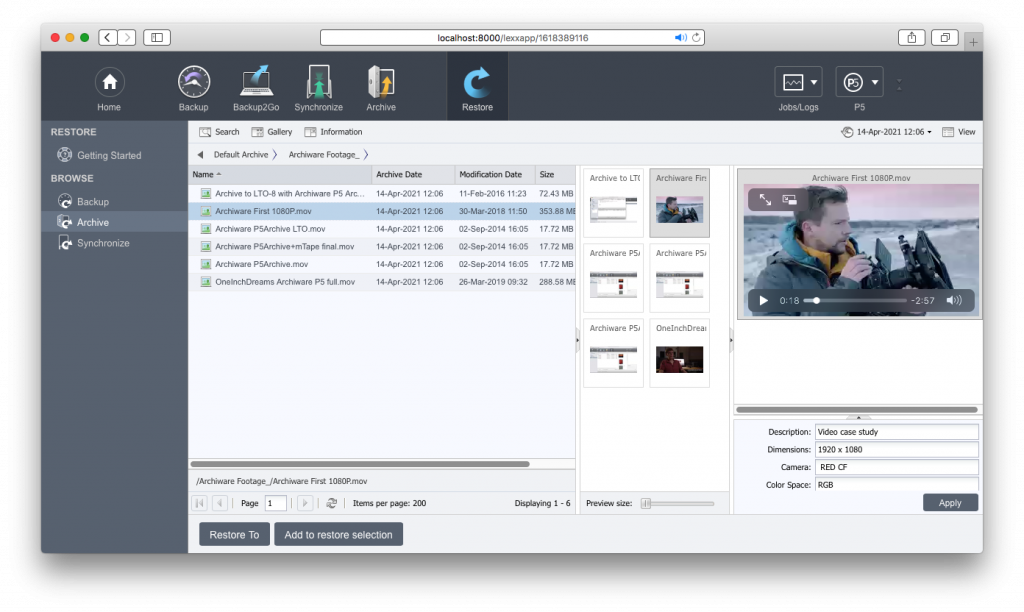
Being at the front-line in the battle often fought between incoming media data and storage constraints, Archiware is well placed to share a few predictions around trends in the storage and management of data. Based on feedback from our partners and customers, we see the following trends in the coming year.
1. Cold Storage becomes media-mainstream
When video media resolutions double, customers’ online storage capacities tend not to scale so quickly. With super-high resolution media creation commonplace, while budgets for storage are tight, customers are getting more familiar with cold storage options and their value benefits.
For context, ‘cold storage’ is where inactive data is kept. Archive data for example, which needs to be retained but doesn’t require quick access. Non-media IT departments often use cold storage for compliance, retaining data for years, with very little chance of it needing to be accessed. Multi-year email and CCTV archival for example. Physical products and cloud services exist to house such data.
Cold storage is considerably cheaper than hot (online, immediately accessible) storage and useful also for long-term retention of media data. P5 archive adds Media Asset Management features on top of cold storage of all types, making it quick and easy to find the right files for reuse, reference and monetisation.

2. Adoption of LTO tape by smaller companies
Ten years ago, the majority of Archiware’s tape customers were using LTO libraries in racks, funded with considerable cap-ex budgets. Today there is much growth in the use of standalone/tabletop LTO drives by small teams and single users. The capacity of 12TB for LTO-8 and 6TB for LTO-7 respectively make it extremely useful for keeping media assets. Driven by the per-TB cost compared with disk and cloud and increased awareness of longevity of tape media versus spinning disk mechanisms this trend is bound to continue.
While latest generations of LTO remain relatively expensive, previous generations offer excellent price/TB ratio versus disk. Thunderbolt connectivity built into drive enclosures allows ease of use, even from the laptops of editors. Tape cartridges are the de-facto way to physically courier data between locations, when WAN speeds aren’t fast enough to hit deadlines.
3. Pressure to have robust ransomware policies
With reports of attacks occurring every 11 seconds, ransomware is an always-increasing challenge facing all organisations. Our MSP partners are busy planning and implementing strategies to protect endpoints (workstations and laptops) and servers in content creation environments. Those that already leverage cold-storage (see above) for archive, can benefit from such storage being off-line and having a physical air gap to make it safe from such attacks.
With easy on-site disk-based backups of endpoints commonplace, the requirement to place backups on immutable storage, at arm’s length, adds complexity to an organisation’s daily data protection activities.
By taking such backups on disk and pushing them to off-line tape or cloud storage, protection against ransomware can be added to existing workflows. Products like P5 Backup and P5 Archive that can easily add LTO and public-cloud storage to existing workflows become increasingly useful to protect against ransomware.
4. Keeping one step ahead by migrating
With a wide choice and historic availability of archive storage formats, the need to move or replicate archive data grows. Examples include data archived on older LTO generations needing to be migrated to newer, bigger tapes. On-site disk archive data might need replicating to the cloud to add off-site protection.
Data is on the move, keeping in step with technology improvements, legal requirements and old-tech obsolescence. Even data archived with one public-cloud provider might require moving to another, to take advantage of differences in cost.
Archiware will continue to provide features and guidance in this area, with an understanding of customer requirements, and a product roadmap to enable flexible migration workflows.

